
The outgoing commander of U.S. Pacific Fleet used his change-of-command and retirement ceremony speech to address the external threat of nations increasingly willing to use military means to exert their influence, and the internal threat of insufficient time and funding to create a ready fleet.
Adm. Scott Swift, at times emotional, made multiple references to last year’s two deadly collisions involving Arleigh Burke-class guided missile destroyers, USS Fitzgerald (DDG-62) and USS John S. McCain (DDG-56), killing 17 sailors serving aboard PACFLEET ships.
“The readiness environment that created the conditions for those individual failures, and the deaths of the Fitzgerald seven and McCain ten, must be improved,” Swift said during the Thursday ceremony at Pearl Harbor.
Speaking of last year’s fatal collisions, Swift said individuals are responsible and must be held accountable, but the Navy must also address the operational atmosphere that created the situation where such collisions were possible.
“First, fully fund the readiness accounts of the Navy we have before we start building a Navy for the future,” Swift said.
The Navy is in pursuit of a 355 ship fleet – up from today’s 283. Service reports, government studies and congressional leaders indicate the Navy is struggling to keep current ships – especially the forward-deployed ships in Pacific Fleet – on regular maintenance schedules.
“For all of us wearing the uniform, the greatest burdens of service are the memories of shipmates we’ve lost along the way,” Swift said.
A pair of in-depth Navy studies, a Comprehensive Review and a Strategic Review – both ordered in the wake of the collisions and completed last winter – provide the Navy with a good plan to improve its operations, Swift said, but the catch is following through and implementing recommendations from the reports.
The collisions and the readiness challenges that led to them, which were found to be endemic throughout the surface fleet, possibly cost Swift the chance to lead U.S. Pacific Command and hastened his retirement from the Navy, several defense officials previously told USNI News. Swift requested to retire in September, after Chief of Naval Operations Adm. John Richardson informed Swift he was not going to be the Navy’s choice to lead U.S. Pacific Command, several sources have told USNI News.
Swift joined the Navy after graduating from San Diego State University, receiving a commission in 1979 through the Aviation Reserve Officer Candidate program. Before leading Pacific Fleet, Swift served as director of Navy Staff at the Pentagon. Among his operational assignments, Swift served as the commander of Strike Fighter Attack Squadron (VFA) 97; commander of Carrier Air Wing 14; deputy commander of naval forces at U.S. Central Command; commander of Carrier Strike Group (CSG) 9; and commander of U.S. 7th Fleet. On shore, among Swift’s assignments included commander of Strike Fighter Weapons School, Pacific; officer of the Under Secretary of Defense for Acquisition, Technology and Logistics staff; and the director of operations for U.S. Pacific Command.
Swift decided to retire while the Navy was conducting several investigations into last year’s spate of Pacific Fleet incidents. The McCain and Fitzgerald collisions were the most serious incidents, but one other U.S. warship suffered a collision while another ran aground in 2017.
Adm. Phil Davidson, who led the CNO-ordered Comprehensive Review, was nominated and recently approved to be the next head of Pacific Command.
Relieving Swift at Pacific Fleet is Adm. John C. Aquilino, who had been commander of U.S. Naval Forces Central Command and U.S. 5th Fleet. Pacific Fleet, which covers 100 million square-miles – half the Earth’s surface – and employs about 140,000 active duty and civilian personnel.
“A great power competition has reemerged as the central challenge to security and prosperity against our nation. Nowhere are the stakes of that great power competition higher than here in the Indo-Pacific region,” Aquilino said.
“To any potential adversary that wishes to challenge us, the Secretary of Defense said it best: ‘You can have no better friend, or you can have no worse enemy’ than the U.S. Pacific Fleet, that choice will be yours.”
Swift’s bosses, CNO and current PACOM commander Adm. Harry Harris, both spoke very highly of Swift. Richardson called the ceremony “a celebration of Pacific Fleet, and a celebration of Adm. Swift’s time in Pacific Fleet.”
Harris cited a few of Swift’s successes. For example, Harris explained Swift developed the 3rd Fleet Forward program to fully leverage PACFLEET power, which includes ships based on the West Coast of the U.S., in Hawaii and in Japan.
“He did this under his own authority,” Harris said. “The result is more lethality, more broadly applied.”





